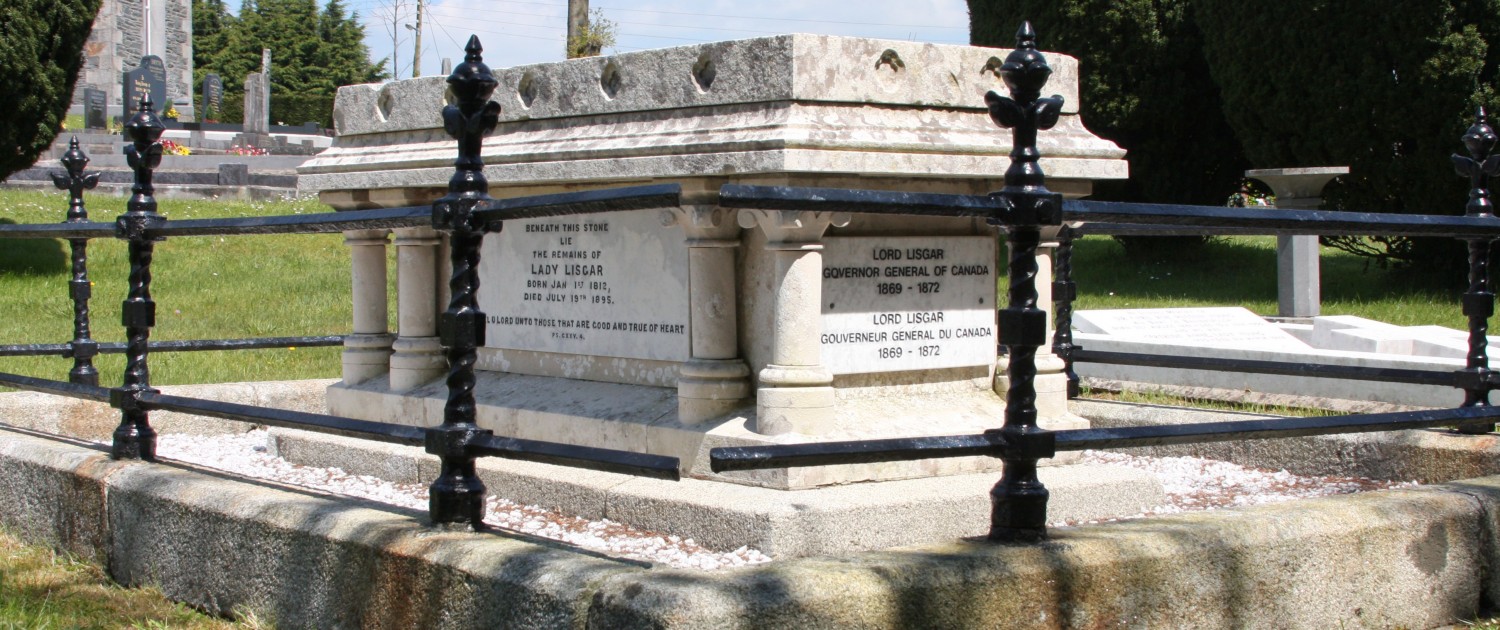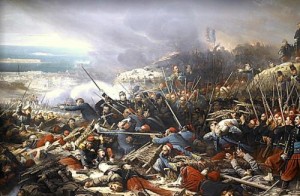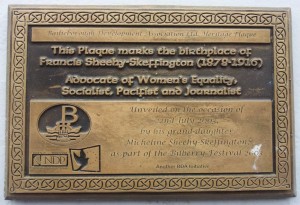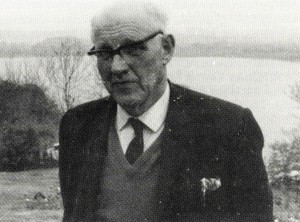Sir John Young – Lord Lisgar (1807 – 1876)
John Young was born in Bombay, India. He was the eldest son of Sir William Young who became the 1st Baronet of Bailieborough Castle. Sir William purchased the Bailieborough Estate in 1814 from Thomas Charles Stewart Corry.
John Young was educated at Eton and Corpus Christi College, Oxford, England. He graduated in 1829 and in 1834 he was called to the Bar. He became a member of Parliament for Co. Cavanin the House of Commons, London in 1831. In 1835 he married Adelaide Annabella Tuite Dalton, who was from Fennor, Oldcastle, Co. Meath. He was Lord of the Treasury for Sir Robert Peel in 1841, secretary of the Treasury in 1844 and Chief Secretary for Ireland from 1852 to 1855. John Young was appointed Lord High Commissioner to the Ionian Islands in 1855. In 1860 he was appointed Governor of New South Wales. He took up the office of Governor General of Canada in 1868. He was granted a peerage on October 26th 1870, “Baron Lisgar of Lisgar and Bailieborough”. When his term in Canada ended in 1872 he returned to live in Bailieborough Castle. He died there on October 6th 1876 aged 69 years. His wife Lady Lisgar remarried, she married Sir Francis Turville of Bosworth Hall, Leicestershire, U.K. Even though the marriage came with a title she chose to continue to be known as Lady Lisgar. Lord and Lady Lisgar had no children; when Lady Lisgar remarried in 1881 she was aged 74 and her new husband was aged 50. The Bailieborough Estate which included Bailieborough Castle was sold in 1900 and Lady Lisgar died in 1902. The remains of both Lord and Lady Lisgar are interred in the family vault in the grounds of Bailieborough Parish Church.
James Owens V.C. (1827 – 1901)
James Owens place of birth is recorded as Killann, Bailieborough. His exact date of birth is uncertain but the year is thought to be 1827. Details about his early life at Killannare unrecorded but he went on to have a distinguished military career. He joined the 49th Regiment of Foot of the British Army which later became the Royal Hertfordshire Regiment. At the age of about 27 on October 26th 1854 while fighting in the Crimean War he was on picket duty during the Siege of Sebastopol. (Picket duty entailed a small group of lookouts placed in advanced locations in front of the main force of troops). This was indeed a very dangerous position. Lieutenant John Connolly from Co. Donegal was the commander of the picket patrol when the battalion was surprised by a company of Russian troops. The commander and his men lead a fierce resistance. Lieutenant Connolly was wounded and became unconscious after he lost a lot of blood. Corporal James Owens came to his rescue and carried him from the scene.
It was this heroic act of bravery that earned Owens a Victoria Cross. He was the first Cavan man to win this prestigious award and one of the first soldiers in Ulster. The Victoria Cross was instituted as a direct result of the Crimean War; it was awarded to any solider regardless of army or navy rank to recognise considerable acts of bravery during the entire Crimean War which commenced in October 1853 and ended in February 1856. Queen Victoria signed the warrant for this new award on January 31st 1856. James Owens was one of several Ulstermen to be “gazetted” on February 24th 1857. Among these men was Charles Davis Lucas from Co. Monaghan, who was the first soldier to win a Victoria Cross. Queen Victoria herself presented the awards on June 26th 1857 at Hyde Park, London. James Owens survived the Crimean War and was later elevated to the rank of Sergeant. Having left the army he worked for some time as a warden at the Tower of London. He died at Romford, Essex, U.K., on August 20th 1901. He is buried in Lorne Rd., Cemetery, Brentwood, Middlesex, England. Sergeant James Owens’ Victoria Cross is displayed in The Rifles Berkshire and Wiltshire Museum, Salisbury, Wiltshire, England.
The Siege of Sebastopol, more than 200,000 men died during the siege.
County Cavan VC Recipients:
Philip Smith VC, Lurgan, Virginia. He was awarded a VC for heroism during the Siege of Sebastopol on June 18th 1855. John McGovern VC, Tullyhaw, Templeport. He was awarded a VC for heroism during the Indian Mutiny at Delhi on June 23rd 1857. George Richardson VC, Derrylane, Killeshandra. He was awarded a VC for heroism during the Indian Mutiny at Kewaine, Trans-Gorga on April 27th 1859. James Somers VC, Belturbet. He was awarded a VC for heroism during the First World War at Gallipoli, Turkey on July 1st/2nd 1915. Marcus Ervine-Andrews VC, Keadue, Cavan. He was awarded a VC for heroism during the Second World War at Dunkirk, France on May 31st/June 1st 1940.
John Wilson Montgomery (1835 – 1911)
Although John Wilson Montgomery was not born in Bailieborough he is worthy of mention because of his association with the town. Information is sketchy but it is known he was a farmer’s son, born at Billis, Virginia. In his early career he was a member of the Royal Irish Constabulary. He later became master of Bailieborough Workhouse and resided in Bailieborough town for many years. John Wilson Montgomery is remembered as a balladeer, poet, antiquarian and writer. While working and living in Bailieborough he was affectionately referred to as, ‘The Sweet Bard of Bailieborough’. One of his earliest writings, c1878, was published under the assumed name of Mervyn Grey, it was entitled Life in the Royal Irish Constabulary. On leaving Bailieborough he went on to become Clerk of the Poor Law Board of Guardians in Downpatrick, Co. Down. While residing in Downpatrick he compiled the following books entitled: Rhymes Ulidian (1887) and Fireside Lyrics (1887). Both books were printed by the Down Recorder, Downpatrick. During his retirement in Bangor, Co. Down he wrote, Round Mourne (1908). John W. Montgomery’s wife Mary Jane died on May 17th 1896 and John W died in Bangor on June 4th 1911. Fireside Lyrics contains over 50 poems. Many relate to his newly adopted county of Down and acquaintances from the area. The prefatory is written by Mr S.C. Hall, Kensington, London. Mr and Mrs S.C. Hall were born in Ireland and became highly regarded authors, writing extensively about Ireland and the Irish. In his prefatory S.C. Hall states: “As poems, but still more as evidence of kindliness of disposition-goodness, I am proud of, and grateful for, my share of them, and to greet their writer as my friend. And I have known personally all the great and most of the lesser poets of the century”.
When John Wilson Montgomery was master of Bailieborough Workhouse he was referred to as ‘The Sweet Bard of Bailieborough’. It would be interesting to know during that period did he compiled any poetry relating to Bailieborough or to County Cavan? If he did so, has it survived?
A Poem from Fireside Lyrics entitled, A Song of the Train
The train, the train, the ponderous train, its human burden bearing;
Through frost and snow, through sleet and rain, its powerful engine tearing.
Let others, if it suits them, sing, o’er stage-coach glories sighing;
For me, I love the rush and swing, of the “forty-miler” flying.
Full forty miles an hour, or more, the great sun o’er us beaming;
Without one conversational bore, to interrupt one’s dreaming.
Along the valleys fresh and green, or round the mountains hoary,
Where once those graceful fays were seen, who now live but in story.
On past Bray Head, at dizzy height, or Drogheda, the noted;
Where people feel their heads grow light, as in the air they’re floated.
Or by the Atlantic’s deep blue waves, or Foyle’s attractive waters,
Where trains whip home from Antrim’s caves, fair Derry’s handsome daughters.
The train, the train, the swift-wheeled train, among the green hills sweeping;
Through frost and snow, through sleet and rain, its steel-ribb’d pathway keeping.
Let others, if it suits them, sing, o’er stage-coach glories sighing;
For me I love the rush and ring, of the forty-miler, flying.
Michael Francis O’Reilly – Brother Potamian (1847 – 1917)
Michael Francis O’Reilly was born at Bailieborough on September 29th 1847. He was son of James and Julia (Finnegan) O’Reilly. The exact location of the O’Reilly Family home is uncertain other than Michael Francis was born at Bailieborough.
He was born during the Great Famine when many hungry and destitute families were seeking shelter in the local Workhouse. Bailieborough Workhouse was built to accommodate 600 inmates and by late 1847 it was dangerously overcrowded as the numbers had increased to over 900. For those who could afford to leave emigration was a better option than to remain in Ireland. James and Julia O’Reilly made a decision which in later years afforded their son Michael a solid education and career he would never have achieved had they remained in Bailieborough. Accounts differ as to when the family set sail for America, one record says it was the year after Michael’s birth and another states it was 1850.
The O’Reilly Family settled in New York and when Michael became of age to attend school he was enrolled at the nearby St. Brigid’s De La Salle primary school. At the age of 12 in 1949 Michael Francis O’Reilly entered a Jesuit Novitiate in Montreal, Canada. He became known as Brother Potamian. On completion of his novitiate Brother Potamian taught in De La Salle schools in Montréal, Québec and St. Louis during the years 1869 to 1870. He was an excellent teacher who was fluent in English, French, Spanish and German, he excelled in Physics, Chemistry and Mathematics. Moving to England in 1870, he was appointed to teach at St. Joseph’s, Brother’s College, Clapham, London. The college was noted for its excellence in teaching Physics, Chemistry and Natural History under the influence of Brother Potamian. In 1878 he obtained his Bachelor of Science degree from the University of London. In 1883 he presented a thesis entitled ‘The Theory of Electrical Measurements’ for which the college awarded him a Doctor of Science degree.
During his years in London Brother Potamian compiled many papers on electricity and magnetism under his own name, M.F. O’Reilly. As a result he became known to many eminent professors and men of science. He organised award winning exhibitions in London, Paris, Vienna and Chicago. As well as his scientific achievements Brother Potamian contributed greatly to Catholic education in London. He was instrumental for the transfer of St Joseph’s College, Clapham to Tooting during the period 1886 to 1888. In 1889 he was elected a Member of Convocation of the University of London and later that year he stepped down as director of the new college at Tooting so he could devote more time to teaching and scientific research.
Fifty years after Michael Francis O’Reilly’s birth in Ireland he returned to his native land as Brother Potamian, when he was appointed Professor of Physics at De La Salle College, Waterford in 1893. By the following June a newly built college was opened, Brother Potamian now had the latest science laboratories at his disposal for performing his experiments. Wilhelm Roentgen a German Professor discovered how to perform x-rays and on December 28th 1895 he demonstrated his new discovery. Early the following year translations appeared in scientific journals and newspapers of the Professors scientific discovery. Brother Potamian studied the Professors method of x-ray and set about performing his own. On April 13th 1896 in De La Salle College, Waterford the first ever x-ray was performed by Brother Potamian in Ireland. With the aid of a six inch spark coil, a small focus cathode ray tube and a wet photographic plate with an exposure time of one minute a radiograph was taken. It revealed the presence of a steel splinter in a young woman’s hand. It was successfully removed by Dr Atkins and his medical team who were in attendance to observe the demonstration. Brother Potamian transferred to Manhattan College, New York in August 1896. He was referred to as “one of the pioneers of radiography” by the New York Herald. His last written contribution was to the Catholic World in October 1916 when he wrote an article entitled “The Coming of Age of the x-Ray”. Brother Potamian O’Reilly died at St Laurence’s Hospital, New York on January 20th 1917, aged 70 years.
The James Family
William James came to Bailieborough from Wales early in the 18th Century. He became a tenant farmer, settling on twenty five acres of land in Corkish, Bailieborough. William married Susan McCartney and they had three sons, Robert, William and John. William the second son left Curkish, for America in 1789. It’s recorded that “he was no more than 18 years old and he took with him a small sum of money and a Latin grammar”. In 1795, William James opened his first store trading in dry goods and farm produce in Albany, New York. He prospered and became a successful and wealthy businessman. In later years he became a director of the New York State Bank and Vice-President of the Albany Savings Bank. His son Henry became a scholar of note, a theologian and a university professor. He was the first of the James family to become a published author. It was the second generation of the James family born in America who became world famous. William James (1842-1910) became a renowned philosopher, psychologist and Harvard professor, sometimes referred to as the “father of pragmatism.” His brother Henry James (1843-1916) was the most renowned of the James family. He became a novelist, compiling 20 novels, 112 stories and 12 plays. He is known for such works as The Portrait of a Lady and Wings of a Dove, among many others. Their sister Alice James (1848-1892) is a well known American diarist. She is known mainly for the posthumously published diary that she kept in the final years of her life.
An old 1st Bailieborough Presbyterian Corglass graveyard map records the James family plot on the right hand side of the pathway close to the front porch of the church. The map states: “James Monument”. However no James burial plot now exists in this location, the headstone is relocated and lies horizontal behind the front perimeter wall. The inscription reads: This Monument was erected by the subscribers of Bailieboro Dispensary to the Memory of Robert James M.D., who having for twelve years faithfully and efficiently discharged the duties of Medical Superintendant of the Institution departed this life 12th Oct. 1841 in the 44th year of his age. “We all do fade as a leaf”. When the existing porch was constructed it is reported that the porch encroached on the James family plot. As a result the James family became members of Bailieborough Parish Church. There are four James family Table Tomb’s in Bailieborough’s old Church of Ireland graveyard and one James headstone located in the graveyard adjacent to the Parish Church. One inscription in the old graveyard records the death of William James on May 3rd 1822 and the death of his wife, Susan on May 19th 1824. Another records the death of their son Robert James who died December 4th 1823 and his wife Jane who died July 28th 1826. Robert and Jane were the parents of Robert James M.D.
L – R: William, Henry and Alice James. Their grandfather William James left his home in Curkish, Bailieborough in 1789. Aged 18 he took with him small sum of money and a Latin grammar.
Francis Sheehy-Skeffington (1878 – 1916)
Francis Skeffington was born in an upper bedroom in the premises now known as Jameson’s Pharmacy, Main Street, Bailieborough. He was the only son born to Joseph and Rose (née Magorian) on December 23rd 1878, his parents were natives of Downpatrick, and they were married in Ballykinlar Roman Catholic Church, Downpatrick, Co. Down in 1869. Joseph Skeffington was a schools inspector and he and his wife were lodging on Main Street, Bailieborough when Francis was born. Francis was first educated at home by his father and then by the Jesuits at St. Stephen’s Green, Dublin, and later in University College Dublin. When he was just 15 years old he wrote a letter to a local newspaper expressing the view that the Irish language was dead and it would be better if the youth of Ireland learned Experanto rather than Irish. While attending UCD he was friends with people like James Joyce and Thomas Kettle, names that became well known in Irish history. While studying in UCD he was active in debating and student politics. He lobbied for equal rights for women and aired the views that they should be admitted to UCD on the same principals as men. He wore a badge proclaiming ‘Equal Rights for Women’, he refused to shave and wore long socks and knickerbockers. In 1897 he became auditor of UCDs Literary and Historical Society. He graduated in 1900 with a B.A., and in 1902 with an M.A.
Francis Skeffington met Hanna Sheehy at college and they were married on June 27th 1903, she was daughter of David Sheehy a Limerick parliamentarian and agrarian radical. When Francis graduated from University College Dublin he worked as a free-lance journalist, his wife was a teacher and the main earner. He adopted his wife’s name in support of women’s rights and became known as Francis Sheehy-Skeffington.
They both supported the struggle for women’s rights and joined the Irish Women’s Suffrage and Local Government Association and the United Irish League. Francis secured a teaching position in St. Kieran’s College, Kilkenny and later he became the first lay register of UCD. This was a position he later resigned from after criticising the college’s stance on not admitting women on equal terms with men. As a couple they founded the Irish Women’s Franchise League in 1908 and on occasions they addressed meetings in the Phoenix Park. Francis was involved in the peace committee during the 1913 Dublin Lock-out. That same year he became vice chairman of the Irish Citizens Army but when it became a military entity he resigned. Due to his pacifist views he opposed the First World War and campaigned against recruitment. As a result he was arrested and imprisoned on May 29th 1915, while in prison he went on hunger strike but was released on June 16th.
To prevent looting, Francis Sheehy-Skeffington attempted to organise a civilian defence force during the 1916 Rising. He opposed civil disobedience while his wife Hanna brought food to the rebels in the General Post Office on O’Connell Street. On April 25th he went into the city centre from his home in Rathmines as he was concerned about the break down in law and order. As he returned home he was arrested for no apparent reason by soldiers of the 11th East Surrey Regiment. He admitted having sympathy for the insurgents cause and as a result he was held as an enemy sympathiser. Later in the evening Captain JC Bowen-Colthurst sent out a raiding party to look for Fenians, they took Sheehy-Skeffington as a hostage with orders that he should be shot if they came upon any resistance. Two journalists were arrested, Thomas Dickson and Patrick McIntyre as well as a Sinn Fein politician Richard O’Connell. The following morning without trial or conviction Francis Sheehy Skeffington, Thomas Dickson and Patrick McIntyre were shot dead, Captain JC Bowen-Colthurst having given the orders. He later raided and ransacked Sheehy Skeffington’s house in an attempt to cover up the murder. Hanna Sheehy-Skeffington did not find out for four days the fate of her husband, he had been hastily buried in the barracks yard (he was reinterred in Glasnevin Cemetery on May 8th 1916). Bowen-Colthurst was deemed insane and as a result he was held in an asylum for eighteen months before he retired to Canada. The then British Government later offered Hanna compensation for the murder of her husband, this she refused. Francis Sheehy-Skeffington was survived by his wife Hanna and son Owen Sheehy-Skeffington who was then aged nine.
Thomas J Barron (1903 – 1992)
Tom was asked to take up the position of trainee teacher (monitor) at Garvagh National school in the early 1930s and he obtained a permanent position in Knockbride National school in 1935. Tom was meticulous in all his work and took the collection and documenting of folklore for the 1937 National Folklore Collection very seriously. In his report to the commission he stated ‘great pains were taken to obtain the most authoritative versions of the different subjects’.Thomas J (Tom) Barron was born on 13 November 1903 to John James Barron and Margaret White. The family home was at Cornaveagh in Knockbride parish. Tom had two brothers and a sister. Tom had a lifelong interest in local history and archaeology and he said that this was nurtured by the family having a stone carved horse which the children in his family played with.
(Reproduced courtesy Tom Sullivan)
Tom Barron had a lifelong interest in St Brigid and he conducted much research into the famous tricephallic (three faced) stone head known as the Corleck Head. The stone head was originally discovered in the nineteenth century at a quarry on Corleck hill in Knockbride parish. The stone was discovered on land belonging to H Gibson Hall and loaned to the National Museum. Tom continued to carry out excavations in the Knockbride area and located the two faced Corraghy head and also a rams head in stone.
In August 1944, he married Sarah Elizabeth Mahood from Canningstown, Co Cavan who was a teacher at Latsey National school in Knochbride parish. He became principal of the Model school Bailieborough in 1950 and continued his research in Knockbride parish. Barron and his friend Patrick McBreen excavated crannogs on lakes in the area and unearthed quern stones and a cannon ball from the 1641 rebellion.
Cumann Seanchais Bhreifne was founded in January 1956 and Tom Barron was a founder member. He contributed articles to the society’s journal ‘Breifne’ and served as president from 1989-1992.
In September 1971 the 400th anniversary of William Bedell’s birth was celebrated with a function in the Farnham hotel and for the occasion Tom Barron set up a display of antiquarian books.
When he retired from teaching he continued his research into local history and undertook journeys to Norway, Greece, Italy and Egypt with his wife to visit museums and archaeological sites there. His wife died in 1978 and Tom spent his final years in Virginia, Co Cavan. He was often interviewed on radio and television for his expert opinion on archaeological matters. He died in March 1992.










